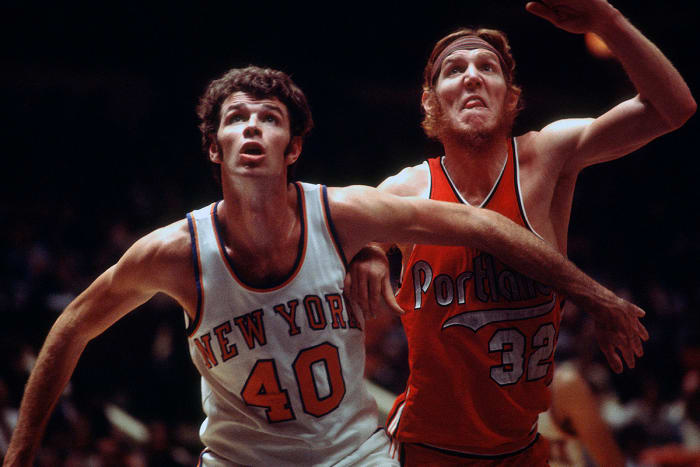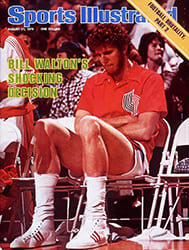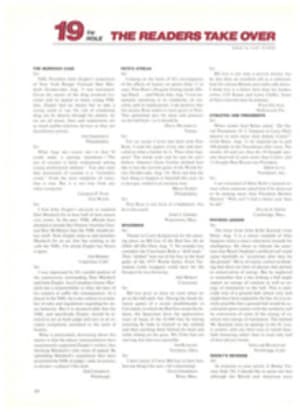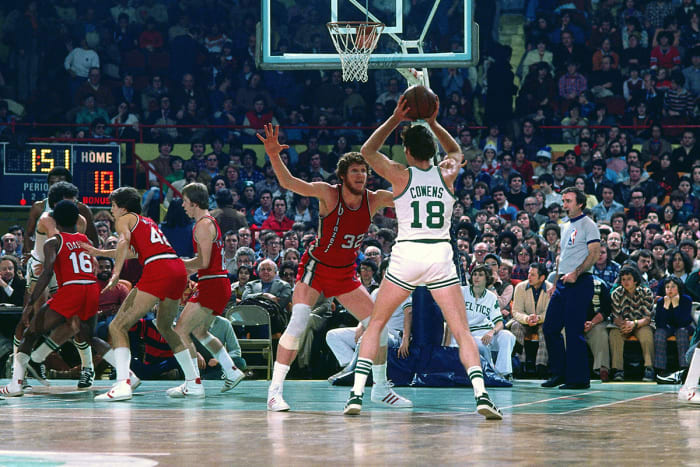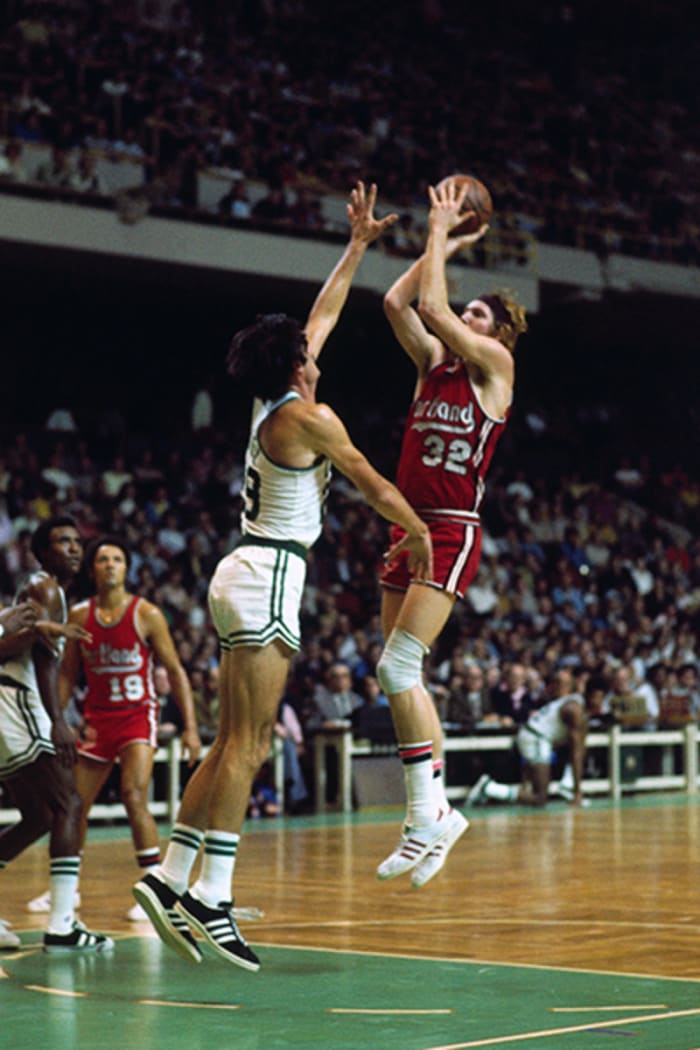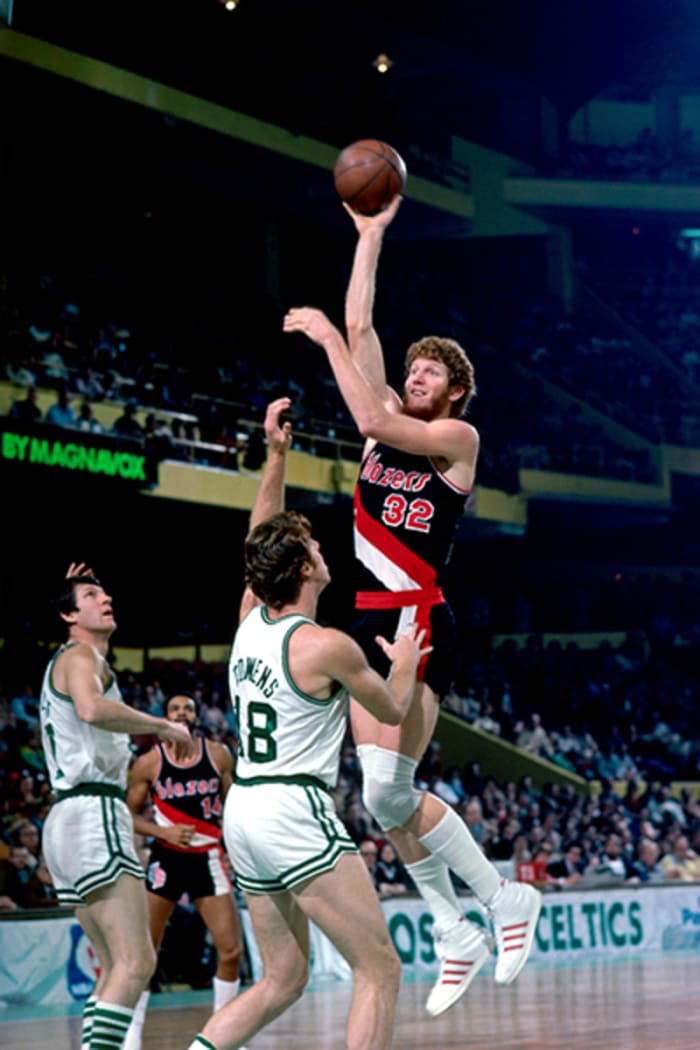Off on a Wronged Foot
Last Friday evening, as reports began circulating that he might miss more than half of the coming season, Bill Walton left a Portland, Ore. clinic with a cast on his left leg. With the addition of the cast, the puzzle of what had happened to Walton, what had made him demand to be traded from the Trail Blazers, grew even more complicated. The sudden move left some friendships strained. It also left the city's basketball fans stunned. Just 14 months before, Walton was leading a raucous victory parade through the streets of downtown Portland after the Trail Blazers had won the National Basketball Association championship.
The initial shock came after a secret meeting in Chicago on Aug. 1 when Walton, who was voted the league's MVP last season, demanded that the Blazers trade him as soon as possible to a team of his choosing, which, late Sunday night, he announced was the Golden State Warriors.
Even more unsettling was the announcement from the Portland club that it "will attempt to abide by his request." And what made the whole thing a mystery was the addendum to which both sides agreed, at Walton's insistence: not to discuss the whys and wherefores of the strange affair.
Last week, however, Walton's reasons for demanding the trade became clearer. He believed that his latest injury—a fractured bone in his left foot, which was diagnosed after he had appeared in a playoff game on April 21—might have been avoided if the Trail Blazers had provided him with proper medical advice and care. Walton also charged the team with the misuse of the pain-modifying drugs Xylocaine and Marcaine, and the anti-inflammatory drugs Butazolidin (phenylbutazone) and Decadron (dexamethasone).
Even when Walton's reasons began to surface, many people, including some Blazer officials, clung to the belief that Walton had a hidden motive. Not money, because as early as last December the Blazers offered to extend Walton's contract beyond next season, when it would expire, and they were apparently willing to pay him what he wanted. There were suggestions that Walton was being misled by his newly designated agents, Jack Scott (the author of a recent book about Walton) and Portland attorney John Bassett. The Blazers' general manager, Harry Glickman, Coach Jack Ramsay and several of the players called attention to a fact that was well known in Portland and—ironically, they felt—documented repeatedly in Scott's book, Bill Walton, On the Road with the Portland Trail Blazers. This fact was that Ramsay and Dr. Robert Cook, the team physician, were two of Walton's closest friends. Moreover, in the book Dr. Cook and Blazer Trainer Ron Culp were described as "sensitive."
"Ron and Bob are two medical people who would almost certainly be retained if the players were selecting the team physician and trainer...." Scott wrote. Said Glickman, "Wouldn't you think that if Bill was mad at Ramsay and Cook, he'd come out and say it?"
Maybe that was exactly the reason why Walton was keeping quiet.
In a prepared statement that Scott read on Aug. 4, Walton said, "This was the most difficult decision I've ever had to make regarding my basketball career. The tremendous loyalty and support of my teammates and the Trail Blazer fans have made that decision much tougher." Except to meet with a parade of coaches and general managers from other teams who came to Portland to bid for Walton's services, he was incommunicado.
The Blazers stuck steadfastly to a statement made by Glickman last week: "Our president Larry Weinberg and I are absolutely shocked by Walton's decision. There was nothing in any prior conversation that he had with anyone in our organization to suggest that he was unhappy or that he was going to ask for a trade."
When the news of Walton's disenchantment with the Blazers reached print, basketball fans all over America were confounded. This was the player who 14 months earlier had been making funny circles over his head and zipping ferocious outlet passes as he led the fast-breaking Blazers to the championship.
The Blazers epitomized team basketball. Ramsay and Walton represented a perfect meld of coach and center, with Walton the center in every respect. And it is significant that the championship came in Walton's first and only healthy season in the NBA. His first two years, 1975-77, were marred by an almost constant series of injuries—including a broken nose, wrist, foot and leg—which caused him to miss 78 of 164 games. The severity of these injuries—at times, the injuries themselves—was questioned by the press, fans, even some of his teammates and team officials. Because he didn't believe in the use of pain-killing drugs, Walton was called a malingerer. He was also criticized for his radical politics and a counter-culture life-style that was alien to the professional sports Establishment; everything from his clothing to his hairstyle to his diet was harpooned. "I've been accused of being a Communist, hiding Patty Hearst and taking LSD before a game," he said recently. He became suspicious of strangers and stopped trying to answer critics.
With the championship, his past was suddenly forgotten. Walton became the cynosure of exuberant Oregon. Nearly everyone who had hated him loved him. Some of his "eccentricities" were even celebrated; his independence was regarded as being consonant with that of all red-blooded Oregonians. He triggered that wonderful disease that became known as Blazermania. Fourteen months later, he may have snuffed it out. Or rather, the "mania" snuffed itself out.
Blazermania gathered steam in the 1977-78 season. Memorial Coliseum's 12,366 seats were sold for every game, and the spillover was lining up to watch on theater TV. By the All-Star break the Blazers were 40-8 and had won 44 straight at home. They were a good bet to break the NBA record of 69-13 and sweep through the playoffs to become the first team since the 1969 Celtics to win back-to-back titles. And they were being compared with the all-time great teams.
Through Feb. 28 they were 50-10, but that night, while the Blazers were beating their archrivals from Philadelphia 113-92, Blazermania went into a holding pattern. Walton fell heavily on his left ankle, aggravating an earlier injury, and had to leave the game. Later it was learned that Walton actually had been bothered by pain in his right foot.
In the very next game, on March 2 in New York, Forward Lloyd Neal collided with teammate Maurice Lucas and fell writhing with an injury to his left knee, which had already been operated on twice to repair torn cartilage.
On March 5 Dr. Bob Cook operated on Walton's right foot for an ailment called interdigital neuroma. Four nerve stems were removed between the second and third toes. The Blazers announced that Walton was expected back in "one to three weeks," but 10 days later Walton still could not walk without limping on his left foot. At the same time, the team announced that Neal would be sidelined until the playoffs. As things turned out, so would Walton.
Soon other Blazers were going down left and right. Lucas missed six of the remaining 19 games with a strained tendon in his right hand and a dislocated finger on his left. Forward Larry Steele missed six games with tendinitis in his right foot. Guard Dave Twardzik was nagged by injuries to his hip, tailbone, wrist and ankle during the stretch run.
On March 23 the Blazers suffered another blow. In Milwaukee, Forward Bob Gross sustained a severe stress fracture of his left ankle. Gross was out for the season, and the Blazers' medical practices became the subject of public speculation for the first time.
Gross' ankle had begun bothering him two weeks earlier. His problem was diagnosed by Cook as tendinitis. No X ray was taken. Cook told Gross to return to Cook's office for an X ray if the symptoms persisted. "Almost without exception we get an X ray before medication is given," Cook said last week. This turned out to be one of those exceptions.
By March 18 Gross still had not had an X ray, but the pain in his ankle was so severe that he needed an injection of Xylocaine to play against Atlanta. That injection was given by Dr. John Hazel, an associate of Cook's who was covering while Cook was away. Three nights later, when the Blazers played Seattle, Gross needed three injections—one before the game, one at halftime and another during the third period. By the time the Blazers reached Milwaukee, the pain was even greater. Hazel switched to Marcaine, a longer-lasting anesthetic. According to Gross, Hazel had to shoot three times before he found the right spot to deaden the pain. Then, his foot numbed. Gross played. "I didn't feel anything when the bone fractured," Gross said last week. "I only heard the noise."
Last week Ramsay said of the incident, "Is it a sin to take a painkiller? I would never allow a player to play if I thought he was risking serious injury. But listen, this is their job. A professional basketball player is capable of deciding for himself whether he should take an injection or not. He knows the risks involved. If he doesn't, he should ask."
Did Gross ask? "They said it was going to numb me," he said. "They said it was tendinitis. You can pump an ankle with tendinitis full of anesthetics and nothing will ever happen. If I had it to do over again I would insist on their finding out exactly what was wrong."
Last week Cook had this to say about the team's policy on anesthetics: "For certain injuries we do not use pain modifiers. We do not, for example, inject major weight-bearing joints. We would not totally anesthetize a person's foot. If we did that and a person played any sport, he could irreparably damage his foot and be totally unaware of any sensation. That is something we do not do."
There had been word that Gross, who is still recovering from the fracture, was considering taking legal action against the Blazers. "I never said I would sue," said Gross, "though I'm sure I could if I wanted to."
With Gross out of the lineup, the pressure grew on everyone to "get healthy." especially Walton. No one had to tell him that even if all the players were in perfect health but him, the Blazers would go nowhere in the playoffs. His right foot had healed after the surgery, but the left was still swollen and painful. On March 28 the Celtics came to town. The Blazers had lost seven of their last nine. Before the game, Walton tried out his left foot, though he hadn't done any running since Feb. 28. He took "oral medication" before the game, either Butazolidin or Decadron. He had taken the drugs at times during the season. So had most of the other ailing Blazers.
Decadron is particularly effective in reducing inflammation, and stronger than Butazolidin. The dosage must be carefully regulated, however, and generally a prescription is required, as prolonged use or excessive dosage can impair the body's defense mechanisms against infection. Also, extended use of the drug can cause loss of texture and strength of bones, resulting in spontaneous fractures. Cook said last week that he verbally instructs Culp to administer Decadron or Butazolidin orally to a specific player for a specific amount of time. "I never use Decadron in oral form on a sustained basis," said Cook. "There are so-called diminishing-dose packs that may be used for a period of three to five days."
Several Trail Blazers said last week that getting Decadron or Butazolidin is no big deal. "You just go to the trainer and tell him you've got a sore shoulder or elbow," said one, "and he says, 'I'll get you some Bute.' Then a little while later it's in your locker." Culp said he only gives medication to a player whose condition Cook knows about, and he carefully records the administration of every last pill, in accordance with NBA rules.
In case Culp forgets to deliver the pill, however, or if Cook does not know about a player's condition, or if the player does not want Cook to know, the player can take Bute or Decadron himself. The drugs are kept in a cabinet in the training room, and while the players are dressing or undressing, the cabinet is usually unlocked. "Everybody knows where it is," said another player. "You don't have to sneak it. They want you to take it. Why do you think it's there?"
Before the March 28 Boston game, Ramsay asked Walton if he could play. Walton said his foot hurt despite the medication, and he did not play. The next three games were in Phoenix, Los Angeles and Seattle. According to Walton, Ramsay insisted he make the trip. Ramsay says that Walton never objected to traveling. "Besides," said Ramsay last week, "Dr. Cook said that Bill's readiness to play could come at any time." The reporters covering the team were under the same impression.
The Oregonian reported on April 1 that Walton, "hobbled by a mysterious injury to his left foot, was sent to Portland Friday, five hours before the Blazers took the court to play Los Angeles.... No longer was anyone in the Blazer family hiding concern."
By April 12, six days before the first playoff game against Seattle, Walton was working out with the team. He was limping noticeably and refused to talk about his injury. He had been to at least four other doctors in addition to Cook; all of the doctors' X rays had been negative and none had been able to pinpoint his injury. On Monday, April 17, Ramsay announced that Walton would start the following night against the SuperSonics. Asked for his reaction, Walton said, "Right now I don't want to talk about my injury or the Seattle series. Whatever Jack Ramsay says about me is the way it is."
On Tuesday night Walton played a heroic game. Although he had missed 22 straight games, and had barely practiced, he played 34 minutes, scored 17 points and had 16 rebounds while the Blazers lost 104-95. The Oregonian reported that Walton "hobbled like a trotting horse who could break down at any time."
On Wednesday he could not walk without pain. He spent most of the day in the whirlpool while the Blazers practiced. On Thursday he practiced but could not run. Game 2 of the Seattle series was on Friday night. Walton was in pain. Cook determined that Walton could take an injection of Xylocaine if he wanted to. Fully aware of what had happened to Gross, Walton's mind was heavy with doubt and conflict. He remembered what he went through his first two years in Portland, and he remembered what it had felt like to win the championship. He remembered Blazer-mania. Cook was his friend. So was Ramsay. No one told him not to take the shot. He took it. It didn't help much. The foot still hurt. He played.
The Blazers beat Seattle 96-93. Walton played 15 minutes in the first half, scored 10 points and got six rebounds. He stayed on the bench the entire second half. After the game Cook said, "I don't know if Bill can play Sunday. We're going to take X rays."
The X rays taken that night at Good Samaritan Hospital were negative. Walton went home, hurting. According to an article last May in the newspaper Willamette Week, by John Bassett, the attorney who would later become Walton's co-agent, "During the middle of the night Cook received a phone call. Said the caller, 'I don't give a damn what you say. Walton has a broken foot.' "
Saturday morning Cook called Walton back to the hospital for more X rays. Finally a fracture was found—a broken tarsal navicular bone below the left ankle. "The break was not related to the pain Walton had been having in the arch of the same foot," says Cook. The fact that Walton had been given an injection before the second Seattle game had been leaked to the press. Cook was asked if the injection could have contributed to the fracture. Cook said the injection was in an area "completely separate from the area of the break." Asked if the injection could have made it possible for Walton to put extra pressure on the bone, forcing it to break, Cook said, "Absolutely not. The area of the break was not numbed. If it had been, he wouldn't have felt the pain until much later than he did."
Walton did not go to any more playoff games, and Seattle won the series four games to two. He stayed in bed most of three weeks. On May 13 he went to a birthday party for Cook and, together with Culp, presented the doctor with a $1,300 motorcycle as a gift. A few days later Walton, cast and all, joined Cook on a raft trip on the Owyhee River. Before he left town, Walton met with Glickman, who was concerned that "those two friends of yours," meaning, Scott and Bassett, were suggesting that Cook had made some serious mistakes in his treatment of some Trail Blazer players. The general manager suggested to Walton that he make a public statement in support of Cook. Walton said he would think about it.
In late June, Cook removed the cast and Walton drove to Eden, Ariz. to soak his foot in the hot springs there. Walton spent a month in Arizona thinking over the events of the previous months. He concluded that in playing with his injured left foot he had gone far beyond what he thought was morally right. He also concluded that he was the one who had made the mistakes, and his biggest mistake was allowing his trust in others—even close friends—to supersede his principles. He would have to make a stand, but he was not yet sure how.
His first Blazer contact upon returning to Portland was with Culp at—wouldn't you know?—a hospital. Walton was admitted to Willamette Falls Hospital on July 13 with a painful sinus condition, and later Culp had come to drive him home. At one point Culp casually suggested that Walton make a public statement supporting Cook and repudiating Scott and Bassett. The words must have had a familiar ring to Walton. And a hollow one. That same morning, Walton's left foot was examined by Cook, who said that the bone was healing normally. But Walton was still hobbling around on crutches.
On July 18 Walton met with Glickman to discuss team matters. In the course of the meeting, Glickman reminded Walton of his earlier request for a statement of support for Cook.
A few days later Ramsay called Walton. "The conversation was pleasant," said Ramsay last week. "It was a friendly talk. He said absolutely nothing to me to suggest he was unhappy with me, or anything else. He even said he was looking forward to coming to training camp. If he had reasons for wanting to be traded I wanted to hear them from him. He didn't need anyone to speak for him."
By the end of July, Walton felt that he had reasons, and he wanted to be traded. He called Blazer President Larry Weinberg and asked for a meeting. At the O'Hare Hilton in Chicago, Walton, accompanied by Bassett and Scott, laid his reasons on the table. Whether he thought the reasons were valid or not, Weinberg agreed to try to trade Walton.
Then last week came the parade. From a list drawn by Walton of teams he would consider joining, San Diego, New York, Golden State and Philadelphia sent representatives in that order. It is safe to say that all left Portland wondering when, if and how well Bill Walton will be able to play basketball. On Friday night, Walton went to the clinic where Dr. David B. Long, an orthopedist, placed a new cast on the same left foot. The tarsal navicular bone, fractured on April 21, had not yet healed, 16 weeks later.
At week's end, Golden State didn't seem fazed by Walton's medical problems and decided—cast or not—that he was worth the risk and whatever the Warriors would have to give up in return. Even if it takes a while to get him on the court.
